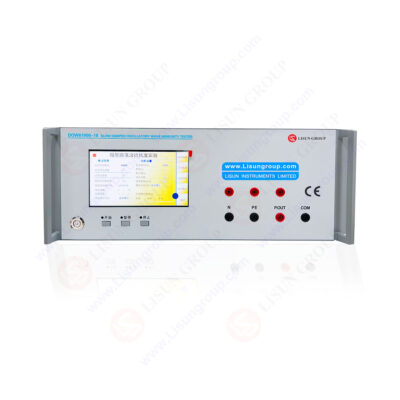

Abstract
The Damped Oscillatory Wave Generator is a crucial instrument for evaluating the electromagnetic compatibility (EMC) of electronic devices, particularly in assessing their immunity to damped oscillatory waves. This paper explores the testing methodologies for both fast and slow damped oscillatory waves, focusing on the LISUN DOW61000-18 Damped Oscillatory Wave Immunity Tester. We provide detailed procedures, specific test parameters, and present data tables to illustrate the testing process.
1. Introduction
Electromagnetic interference (EMI) poses significant challenges to the reliability and performance of electronic equipment. The IEC 61000-4-18 standard outlines testing methods for damped oscillatory waves, which are common sources of EMI. The LISUN DOW61000-18 Damped Oscillatory Wave Immunity Tester is designed to evaluate the immunity of devices under test (DUT) to these disturbances.
DOW61000 18_Damped Oscillatory Wave Immunity Tester
2. Overview of the Damped Oscillatory Wave Generator
The DOW61000-18 is engineered to generate damped oscillatory waves with precise control over voltage, frequency, and waveform characteristics. It complies with international standards, ensuring reliable and repeatable testing conditions. The tester offers both slow and fast damping options, accommodating a wide range of testing requirements.
3. Testing Methodology
3.1 Preparation
• Calibration: Ensure the tester is calibrated according to the manufacturer’s specifications.
• Setup: Connect the DUT to the tester, ensuring all connections are secure and meet safety standards.
3.2 Test Parameters
The following table summarizes the key parameters for both slow and fast damped oscillatory wave testing:
Parameter
Slow Damped Oscillatory Wave
Fast Damped Oscillatory Wave
Output Voltage
200V–3kV ±10%
450V–4.4kV ±10%
Oscillation Frequency
100kHz ±10%, 1MHz ±10%
3MHz, 10MHz, 30MHz ±10%
Pulse Polarity
Positive, Negative, or Auto
Positive, Negative, or Auto
Rise Time
75ns ±20%
5ns ±30%
Voltage Attenuation
VPK5 > 50% × VPK1, VPK10 < 50% × VPK1
VPK5 > 50% × VPK1, VPK10 < 50% × VPK1
Repeat Frequency
1–100Hz (oscillation frequency is 100kHz) continuously adjustable
Max. 5,000/s ±10%
Burst Width
1–9999s (Adjustable)
3 MHz: 50ms ±20%
10 MHz: 15ms ±20%
30 MHz: 5ms ±20%
Pulse Interval
1–9999s (Adjustable)
300ms ±20%
Internal Resistance
200Ω
50Ω
EUT Power Supply
AC 600V/32A; DC 1000V/32A
AC 380V/16A; DC 300V/16A
Power Supply
AC85~264V/Single Phase
AC85~264V/Single Phase
Note: The above specifications are based on information provided by LISUN.
3.3 Testing Procedure
• Configuration: Set the desired test parameters on the tester, including voltage, frequency, and pulse characteristics.
• Execution: Initiate the test sequence, allowing the tester to generate the damped oscillatory waves and apply them to the DUT.
• Monitoring: Continuously monitor the DUT for any signs of malfunction or degradation during the test.
• Data Collection: Record the DUT’s performance metrics throughout the testing phase.
4. Data Analysis
After completing the tests, analyze the collected data to assess the DUT’s immunity to damped oscillatory waves. Compare the results against the acceptable limits specified in the relevant standards to determine compliance.
5. Conclusion
The LISUN DOW61000-18 Damped Oscillatory Wave Immunity Tester provides a comprehensive solution for evaluating the electromagnetic compatibility of electronic devices. By adhering to standardized testing procedures and utilizing precise instrumentation, manufacturers can ensure their products meet the necessary immunity requirements, thereby enhancing their reliability and performance in real-world applications.
References
IEC 61000-4-18: Electromagnetic compatibility (EMC) – Part 4-18: Testing and measurement techniques – Damped oscillatory wave immunity test.
LISUN DOW61000-18 Product Information: https://www.lisungroup.com/products/emi-and-emc-test-system/damped-oscillatory-wave-immunity-tester.html https://www.lisungroup.com/news/technology-news/testing-fast-and-slow-damped-oscillatory-waves-using-the-damped-oscillatory-wave-generator.html


Comments
Post a Comment